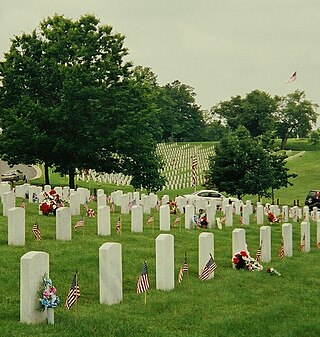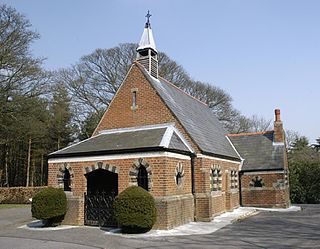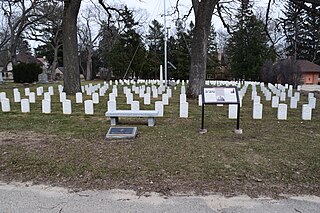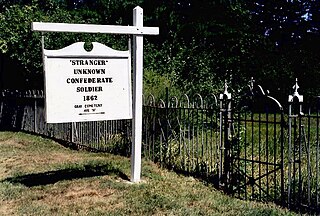
Camp Nelson Confederate Cemetery is a historic cemetery located near Cabot in northern Lonoke County, Arkansas and is near the site of a Confederate military camp Camp Hope, where 1,500 Confederate soldiers died during an epidemic during the fall of 1862. Camp Nelson Cemetery is located on Rye Drive, just off Cherry Road, just off Mt. Carmel Road in north Lonoke County about 2 miles east of Cabot.

The Andersonville National Historic Site, located near Andersonville, Georgia, preserves the former Andersonville Prison, a Confederate prisoner-of-war camp during the final fourteen months of the American Civil War. Most of the site lies in southwestern Macon County, adjacent to the east side of the town of Andersonville. The site also contains the Andersonville National Cemetery and the National Prisoner of War Museum. The prison was created in February 1864 and served until April 1865.

Oak Woods Cemetery is a large lawn cemetery in Chicago, Illinois. Located at 1035 E. 67th Street, in the Greater Grand Crossing area of Chicago's South Side. Established 171 years ago on February 12, 1853, it covers 183 acres (74 ha).

Camp Randall was a United States Army base in Madison, Wisconsin, the largest staging point for Wisconsin troops entering the American Civil War. At this camp fresh volunteers received quick training before heading off to join the Union Army. Also located on the grounds were a hospital and briefly a prisoner-of-war camp for captured Confederate soldiers.

Stanley Military Cemetery is a cemetery located near St. Stephen's Beach in Stanley, Hong Kong. Along with the larger Hong Kong Cemetery, it is one of two military cemeteries of the early colonial era, used for the burials of the members of the garrison and their families between 1841 and 1866. There were no further burials here until World War II (1939–1945).

Camp Butler National Cemetery is a United States National Cemetery located a few miles northeast of Springfield and a few miles southwest of Riverton, a small town nearby to Springfield, in Sangamon County, Illinois. It was named for the Illinois State Treasurer at the time of its establishment, William Butler. Administered by the United States Department of Veterans Affairs, it occupies approximately 53 acres (21 ha), and is the site of 19,825 interments as of the end of 2005. Camp Butler National Cemetery was placed on the National Register of Historic Places in 1997.

Camp Nelson National Cemetery is a United States National Cemetery located in southern Jessamine County, Kentucky. It was originally a graveyard associated with the U.S. Army's Camp Nelson, which was active during the U.S. Civil War and its aftermath. The camp was named for Major General William "Bull" Nelson, commander of the Civil War Army of Kentucky, who was murdered by a fellow officer in 1862.

Crown Hill National Cemetery is a U.S. National Cemetery located in Indianapolis, Marion County, Indiana. It was established in 1866 on Section 10 within Crown Hill Cemetery, a privately owned cemetery on the city's northwest side. Administered by the United States Department of Veterans Affairs, the National Cemetery encompasses 1.4 acres (0.57 ha) and serves as a burial site for Union soldiers who fought in the American Civil War.

Finn's Point National Cemetery is a United States National Cemetery located in Pennsville Township, Salem County, New Jersey, United States. It encompasses 4.6 acres (1.9 ha), and as of February 2009, had 3,033 interments. Adjacent to Fort Mott, it is governed by the United States Department of Veterans Affairs and administered by the Washington Crossing National Cemetery.

Camp Chase was a military staging and training camp established in Columbus, Ohio, in May 1861 after the start of the American Civil War. It also included a large Union-operated prison camp for Confederate prisoners during the American Civil War.

Aldershot Military Cemetery is a burial ground for military personnel, or ex-military personnel and their families, located in Aldershot Military Town, Hampshire.

Forest Hill Cemetery is located in Madison, Wisconsin, and was one of the first U.S. National Cemeteries established in Wisconsin.
General Michael Jackson was a soldier from Massachusetts.

Camp Morton was a military training ground and a Union prisoner-of-war camp in Indianapolis, Indiana, during the American Civil War. It was named for Indiana governor Oliver Morton. Prior to the war, the site served as the fairgrounds for the Indiana State Fair. During the war, Camp Morton was initially used as a military training ground. The first Union troops arrived at the camp in April 1861. After the fall of Fort Donelson and the Battle of Shiloh, the site was converted into a prisoner-of-war camp. The first Confederate prisoners arrived at Camp Morton on February 22, 1862; its last prisoners were paroled on June 12, 1865. At the conclusion of the war, the property resumed its role as the fairgrounds for the Indiana State Fair. In 1891 the property was sold and developed into a residential neighborhood known as Morton Place, a part of the Herron-Morton Place Historic District.

Liendo Plantation is an historic cotton plantation in Waller County, Texas, United States. Named after its original owner, José Justo Liendo, the plantation was purchased in 1873 by sculptor Elisabet Ney and her husband, physician Edmund Montgomery.
Patrick R. Cleburne Confederate Cemetery is a memorial cemetery located in the city of Jonesboro, Georgia, United States. It was named in honor of General Patrick Cleburne. This cemetery was a burial site for Confederate soldiers who died in the Battle of Jonesboro in 1864. This cemetery is open daily until dusk. It is one of six Confederate cemeteries maintained by the Georgia Building Authority.

Greenlawn Cemetery was a cemetery located in Indianapolis, Indiana, from 1821 to 1931.

The Confederate Soldiers and Sailors Monument was a large granite monument that sat at the south entrance of Garfield Park in Indianapolis for nearly a century, before being removed in 2020. It commemorated the Confederate prisoners of war that died at Camp Morton. At 35 feet (11 m) tall and located in the city's oldest public park, it had been the most prominent of the very few Confederate memorials in the Union state of Indiana. It was dismantled and removed by the city of Indianapolis in June 2020 after a yearslong debate, part of a national wave of removal of Confederate memorials during the Black Lives Matter movement.

The Unknown Confederate Soldier of Gray, Maine is an unidentified uniformed man whose body was mistakenly sent to the family of fallen Union soldier Charles H. Colley in Gray, Maine in 1862 during the American Civil War.


















